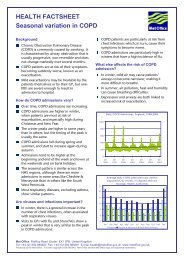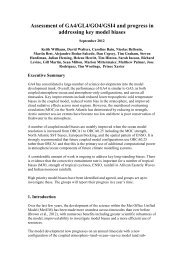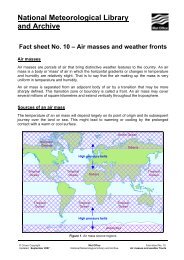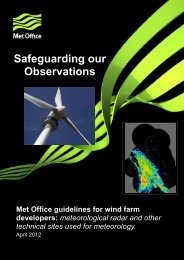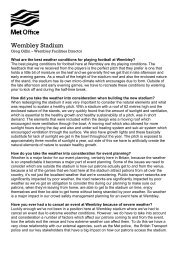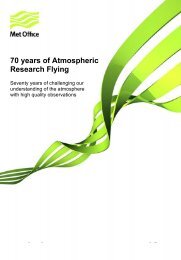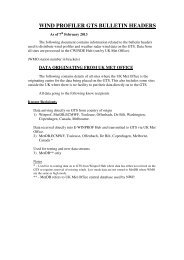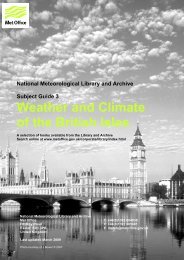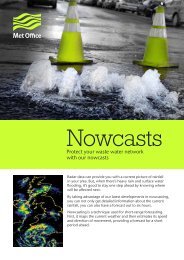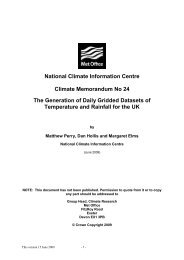Description and assessment of the OSTIA reanalysis. - Met Office
Description and assessment of the OSTIA reanalysis. - Met Office
Description and assessment of the OSTIA reanalysis. - Met Office
You also want an ePaper? Increase the reach of your titles
YUMPU automatically turns print PDFs into web optimized ePapers that Google loves.
Quality level 3,4 <strong>and</strong> 5 Quality level 5<br />
Regions Mean (RMS) No. <strong>of</strong> obs Mean (RMS) No. <strong>of</strong> obs<br />
Global -0.24(0.84) 1579712 -0.06(0.86) 414936<br />
North Atlantic -0.08(0.83) 245197 -0.05(0.93) 61849<br />
North Pacific -0.24(0.86) 361846 -0.04(0.91) 102795<br />
South Pacific -0.29(0.76) 344913 -0.04(0.70) 74871<br />
South Atlantic -0.24(0.77) 100920 -0.02(0.71) 20272<br />
Mediterranean 0.08(0.78) 36333 0.14(0.77) 22344<br />
Arctic -0.15(1.21) 31508 -0.15(1.12) 20037<br />
Sou<strong>the</strong>rn Ocean -0.34(0.88) 160925 -0.07(0.78) 36732<br />
Indian -0.30(0.82) 271524 -0.18(0.73) 63824<br />
Tropics -0.32(0.78) 847599 -0.16(0.73) 95589<br />
Table 3.1: Average regional ATSR-1 observation minus background bias(RMS) in K <strong>and</strong> no. <strong>of</strong><br />
observations for experimental runs using ATSR-1 quality level 3,4 <strong>and</strong> 5 <strong>and</strong> 5 data<br />
It is worth noting that in <strong>the</strong> tropics mean bias is decreased from 0.12K to 0.07K <strong>and</strong> <strong>the</strong> RMS<br />
decreases from 0.88K to 0.87K. As <strong>the</strong> in-situ observation statistics are used to quantify bias <strong>and</strong><br />
accuracy for validation purposes <strong>and</strong> <strong>the</strong>se showed improvement in <strong>the</strong> run with <strong>the</strong> lower quality<br />
data both globally <strong>and</strong> in <strong>the</strong> Tropics where <strong>the</strong> additional ATSR-1 data was located, <strong>the</strong> decision<br />
was made to use data <strong>of</strong> quality level 3,4 <strong>and</strong> 5 in <strong>the</strong> <strong>reanalysis</strong>.<br />
A fur<strong>the</strong>r set <strong>of</strong> experiments was carried out to ascertain whe<strong>the</strong>r <strong>the</strong> ATSR-1 data (levels?)<br />
should be bias corrected to <strong>the</strong> in-situ observations or assimilated without any bias correction. Two<br />
experimantal runs were carried out for August <strong>and</strong> September 1991. Tables 3.4 <strong>and</strong> 3.4 show <strong>the</strong><br />
observation minus background statistics globally <strong>and</strong> regionally for <strong>the</strong> ATSR-1 <strong>and</strong> in-situ observations<br />
averaged over August <strong>and</strong> September for runs with <strong>and</strong> without bias correcting <strong>the</strong> ATSR-1<br />
data. The tables show <strong>the</strong> expected statistical outcome <strong>of</strong> <strong>the</strong> bias correction to <strong>the</strong> insitu data with<br />
<strong>the</strong> ATSR-1 observational bias increasing globally from -0.11K to -0.24K when <strong>the</strong> bias correction<br />
is carried out, whilst as expected <strong>the</strong> in-situ bias decreases from 0.05K to 0K. The global ATSR-1<br />
observation minus background RMS increases from 0.76K to 0.84K whilst <strong>the</strong> in-situ observation<br />
minus background RMS remains unchanged when <strong>the</strong> bias correction is carried out. The same<br />
pattern is seen across almost all <strong>the</strong> regions. Taking into account <strong>the</strong> in-situ results <strong>and</strong> <strong>the</strong> desire<br />
to make <strong>the</strong> different sources <strong>of</strong> observations as consistent as possible <strong>the</strong> decision was made to<br />
© c Crown Copyright 2011 31




